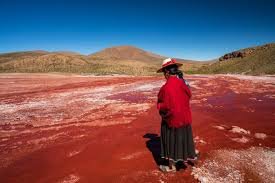In the rugged landscapes of southern Yemen, where the desert meets the Arabian Sea, lies one of the planet’s most surreal natural phenomena—Abyan’s Crimson Sands. Unlike ordinary golden deserts, this rust-colored expanse looks as if the earth itself is bleeding, a spectacle that has inspired war legends, alchemical myths, and scientific curiosity for centuries. Few places on Earth evoke such immediate visceral reactions, and fewer still conceal as many untold stories beneath their shifting crimson dunes.
Abyan’s Crimson Sands: A Geological Anomaly in the Desert
The striking red hue of Abyan’s sands comes from iron oxide—the same compound that gives Mars its nickname “the Red Planet.” But what makes Abyan extraordinary is the concentration and vibrancy of this coloration, which local geology suggests was intensified by ancient volcanic activity. When rare rains fall, the sand temporarily darkens to a deep burgundy, creating the illusion of wet blood across the dunes. Scientists have also identified traces of rare minerals like cinnabar, historically used to produce mercury, leading to speculation about the area’s role in medieval alchemy.
The War Legend That Named the Sands
Oral histories claim the sands gained their bloody hue during a 7th-century battle between rival tribes. As the story goes, the fighting was so fierce that the ground absorbed the blood of fallen warriors, permanently staining the earth. A darker variation suggests a betrayed general cursed the land after his massacre, vowing it would “wear the blood of treachery forever.” Modern historians note these tales likely emerged from real conflicts during Yemen’s pre-Islamic period, when Abyan was a strategic corridor for frankincense caravans vulnerable to raids.
The Alchemists’ Secret Testing Ground
During Islam’s Golden Age, Abyan’s sands were allegedly sought after by alchemists who believed the iron-rich particles could accelerate metal transmutation. A 13th-century Persian manuscript mentions a “crimson powder” harvested here and combined with quicksilver in failed attempts to create gold. Intriguingly, British archaeologists in the 1930s uncovered a buried workshop near the dunes containing primitive crucibles and mercury residues—potential evidence of these experiments. Some theorists even link the site to the legendary Jabir ibn Hayyan, father of Arabic chemistry, though no definitive proof exists.
Abyan’s Crimson Sands: The Phantom Army Mirage
One of Abyan’s most persistent mysteries is the recurring vision of a spectral army marching at dawn. Bedouin traders have reported seeing shadowy figures in ancient armor emerging from the red haze, only to vanish when approached. Meteorologists attribute this to superior mirages caused by temperature inversions over the warm sands, but locals insist the apparitions align with historical battle dates. In 2001, a French documentary crew claimed to capture these figures on thermal cameras—footage later lost during Yemen’s political unrest.

The Singing Dunes Phenomenon
On exceptionally windy days, Abyan’s dunes produce deep, resonant booms likened to distant war drums—a rare acoustic event known as “singing sands.” Research indicates the iron oxide coating alters the sand grains’ friction properties, creating lower-frequency sounds than typical singing dunes. For the local Fadhli tribe, these sounds are the voices of buried warriors, and tradition forbids whistling at night to avoid “awakening” them. Geologists studying the phenomenon discovered the sand’s unique electromagnetic signature, possibly explaining why compasses behave erratically here.
The British Colonial Blood Diamond Ruse
In the early 20th century, British explorers circulated rumors that Abyan’s sands concealed blood-red diamonds washed down from mythical mountains. This was later revealed as a deliberate hoax to justify mineral surveys during their occupation of Aden. Secret colonial documents declassified in 2017 show the British suspected the area contained uranium-bearing minerals, though no significant deposits were ever found. The myth persists today, with occasional treasure hunters still sifting the sands for non-existent gems.
The Unexplained Animal Behavior
Wildlife acts unusually in Abyan’s red zone—foxes dig shallow pits and roll in the sand as if ritually anointing themselves, while migratory birds avoid resting here despite the location along their flight path. A 2019 study found higher-than-normal magnetic readings in the sand, potentially disrupting animals’ navigation. More unsettling are Bedouin accounts of goats refusing to graze near certain dunes, a behavior typically associated with predator presence—though no large predators exist in the area.
Modern Conflict and the Sands’ Symbolism of Abyan’s Crimson Sands
During Yemen’s recent civil war, Abyan’s sands took on grim new symbolism as frontline fighting stained the earth with actual blood. Rebel factions spread propaganda claiming the dunes darkened further during major battles—a phenomenon disproven but widely believed. Today, the area remains dangerously inaccessible, with landmines and unexploded ordnance buried beneath the iconic red sands. Conservationists worry that future industrial development or illicit mineral extraction could irreparably alter this otherworldly landscape.
Abyan’s blood-red sands remain one of Yemen’s most mesmerizing and least understood wonders. Whether viewed through the lens of geology, history, or folklore, they compel us to confront the powerful ways in which landscapes become repositories of human memory—where the very earth seems to remember the blood spilled upon it. For now, the dunes continue their slow, crimson dance, keeping their deepest secrets beneath the shifting surface.
Go to main page


